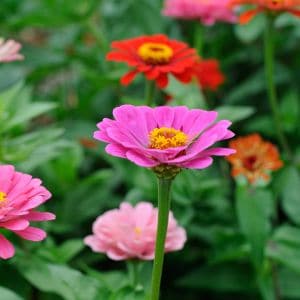If you’re a gardener or someone who loves to decorate your home with fresh flowers, you may have come across zinnias. These colorful and vibrant flowers are a popular addition to gardens and floral arrangements, but have you ever wondered if they are edible?
This post may contain affiliate links.
The short answer is yes, zinnias are edible, but there are a few things you should know before you start eating them.
Zinnias are part of the Asteraceae family, which includes many other edible flowers such as daisies, marigolds, and chamomile.
The petals of zinnias are the edible part of the flower, and they come in a variety of colors including red, orange, yellow, pink, and purple. However, it’s important to note that not all zinnia varieties are edible, so you should always do your research before consuming them.
Related Article: How to Grow Zinnias from Seeds: A Beginner’s Guide
What Are Zinnias?
If you’re looking for a colorful and easy-to-grow annual flower for your summer garden, zinnias might just be the perfect choice for you. These cheerful flowers, which are native to Mexico, come in a wide variety of colors and sizes, and are known for their ability to thrive in full sun.
Characteristics of Zinnias
Zinnias are typically grown as annuals, meaning that they complete their life cycle in one growing season. However, some varieties of zinnias can be grown as perennials in warmer climates.
Related Article: What to Plant in March: A Guide to Spring Planting
Zinnias are known for their bright, showy blooms, which come in a range of colors including pink, red, orange, yellow, and white. The flowers can be single or double, and can be as small as one inch in diameter or as large as six inches.
Variety and Colors
Zinnias come in a wide variety of colors and sizes, making them a popular choice for gardeners who want to add a splash of color to their summer landscape. Some popular varieties of zinnias include:
- Thumbelina: This variety of zinnia is known for its small, compact size and its range of bright colors, including pink, red, and yellow.
- Benary’s Giant: As its name suggests, this variety of zinnia produces large, double blooms in a range of colors including pink, orange, and yellow.
- Profusion: This variety of zinnia is known for its long-lasting blooms and its ability to resist disease. It comes in a range of colors including pink, red, and white.
Whether you’re looking for a bold and bright statement flower or a subtle accent for your garden, zinnias are a great choice. With their easy-to-grow nature and wide range of colors and sizes, they’re sure to bring a smile to your face all summer long.
Related Article: Annuals; 5 Easy to Grow Flowers
Culinary Uses of Zinnias
Zinnias are not only beautiful to look at but are also edible. They can be used in a variety of ways to add color and flavor to your dishes. Here are some ideas for using zinnias in your culinary creations.
Zinnias in Salads and Garnishes
Zinnias can be a great addition to salads, adding both color and a mild, slightly sweet flavor. You can use the petals or the whole flower, depending on your preference.
Simply wash the flowers and remove the stems and any green parts, then sprinkle them on top of your salad. Zinnias also make a great garnish for soups and other dishes.
Related Article: How to Save Seeds from Zinnias: A Beginner’s Guide
Decorative Uses in Desserts and Drinks
Zinnias can be used to decorate cakes, cupcakes, and other desserts. Simply place the flowers on top of your frosting or whipped cream for a beautiful and unique presentation.
Zinnias can also be used to add color and flavor to drinks. Try freezing the petals in ice cubes for a fun and festive touch to your beverages.
Related Articles: Attract Hummingbirds and Butterflies to Your Garden with These Plants
Growing Edible Zinnias
Here’s what you need to know to grow your own edible zinnias.
Planting and Care
Zinnias are easy to grow and can be planted directly in your garden or in a pot. They prefer well-draining soil and full sun, but can also tolerate partial shade. Plant the seeds about ¼ inch deep and 4-6 inches apart. Water regularly to keep the soil moist, but not waterlogged.
Once the zinnias have sprouted, thin them out so they are spaced about 8-12 inches apart. This will allow for better air circulation and help prevent diseases. Fertilize the zinnias every 4-6 weeks with a balanced fertilizer to encourage healthy growth.
Related Article: How to Grow Zinnias in Pots: A Beginner’s Guide
Maintenance and Pruning
To keep your zinnias looking their best, deadhead them regularly. This means removing the spent flowers to encourage new blooms. Zinnias are drought-tolerant, but if you live in an area with hot, dry summers, you may need to water them more frequently.
Zinnias also benefit from occasional pruning. This helps to promote bushier growth and prevent the plants from becoming too leggy. Cut back the stems by about one-third in early summer and again in late summer.
When it’s time to harvest your zinnias, simply pluck the petals off the flower head and rinse them thoroughly before using them in your favorite dish. Don’t forget to compost the leftover stems and leaves to enrich your soil for next year’s zinnias.
Related Article: How to Deadhead Zinnias: A Friendly Guide
Health and Safety Considerations
Toxicity and Allergens
Zinnias are generally considered non-toxic to humans and pets, including dogs and cats. However, some people may experience an allergic reaction to zinnias, particularly if they have a known allergy to plants in the Asteraceae family, which includes daisies and sunflowers.
Symptoms of an allergic reaction may include skin irritation, redness, and swelling. If you experience any of these symptoms after handling zinnias, stop immediately and wash your hands thoroughly with soap and water.
Pesticides and Chemicals
When growing zinnias, it is important to consider the use of pesticides and other chemicals. While zinnias themselves are not typically treated with synthetic fertilizers, herbicides, or insecticides, they may be grown in soil that has been treated with these chemicals.
Additionally, neem oil and insecticidal soaps may be used to control pests on zinnias. If you are concerned about exposure to these chemicals, consider growing zinnias organically or purchasing zinnias from a reputable source that does not use harmful chemicals.
Related Article: When to Pinch Zinnias: A Quick Guide
Frequently Asked Questions
Can you eat the petals of zinnias?
Yes, you can eat the petals of zinnias. They have a slightly bitter taste and can be used as a colorful addition to salads or as a garnish for desserts.
Is it safe for dogs to consume zinnias?
No, it is not safe for dogs to consume zinnias. Zinnias contain compounds that can be toxic to dogs and other animals if ingested.
Related Article: Growing Sunflowers in Containers: Tips and Tricks
Which parts of zinnias are safe for human consumption?
In addition to the petals, the leaves and stems of zinnias are also safe for human consumption. However, it is important to note that some people may have an allergic reaction to zinnias.
Are there any health benefits associated with eating zinnias?
While zinnias are not a significant source of nutrients, they do contain some antioxidants and may have anti-inflammatory properties. However, more research is needed to fully understand the potential health benefits of consuming zinnias.
Do zinnias have a pleasant taste when added to dishes?
The taste of zinnias is subjective and can vary depending on the individual. Some people enjoy the slightly bitter taste of zinnia petals, while others may find it unpleasant.
What should I be aware of when using zinnias as a garnish?
When using zinnias as a garnish, it is important to ensure that they are free of pesticides or other chemicals. Additionally, it is best to use fresh zinnias as they can wilt quickly once cut.
Finally, be aware that some people may have an allergic reaction to zinnias, so it is important to inform guests if zinnias are included in a dish.
Follow my gardening board on Pinterest.



